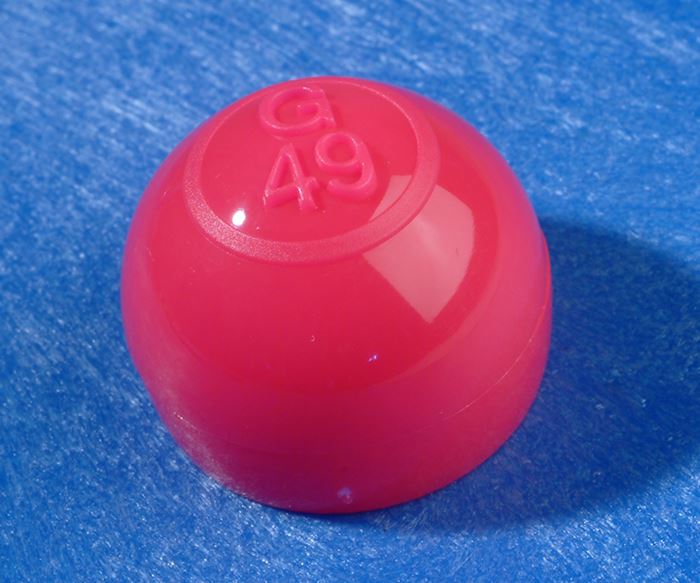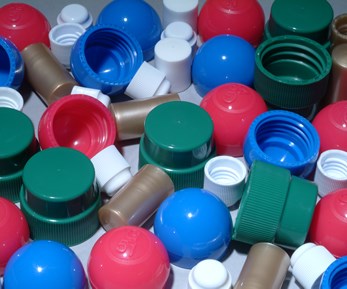Tips and Techniques: How to Mold & Extrude Using Chemical Foaming Agents
Here are some tips and techniques for extruders and injection molders to refer to when using CFAs.
Thermoplastics can be foamed in a number of ways to obtain various densities. Generally speaking, a blowing agent is mixed with the
polymer melt to obtain a plastic article with reduced density by displacing polymer with gas. However, the density or weight reduction is only one of several advantages that foamed plastics have to offer. Other common benefits include sink removal, reduced warpage, and increased production speed.
Blowing or foaming agents fall into two general classes—physical and chemical. Various gasses and volatile liquids are used as physical blowing agents. Chemical foaming agents (CFAs) can be organic or inorganic compounds that release gasses upon thermal decomposition. CFAs are typically used to obtain medium- to high-density foams, and are often used in conjunction with physical blowing agents to obtain low-density foams. This article covers basic processing information for CFAs in extrusion and injection molding.
CFAs can be categorized as either endothermic or exothermic, which refers to the type of decomposition they undergo. Endothermic types absorb energy and typically release carbon dioxide and moisture upon decomposition, while the exothermics release energy and usually generate nitrogen when decomposed. The overall gas yield and pressure of gas released by exothermic foaming agents is often higher than that of endothermics.
Blends of these two classes are sometimes utilized for certain applications. Such is the case for profile extrusion, where the high gas pressure and volume from the exothermic portion help fill the profile while the controlled gas yield and cooling from endothermic decomposition reduce profile warpage.
Endothermic CFAs are generally known to decompose in the range of 130 to 230 C (266-446 F), while some of the more common exothermic foaming agents decompose around 200 C (392 F). However, the decomposition range of most exothermic CFAs can be reduced by addition of certain compounds.
CFA & POLYMER SELECTION
Most CFAs are engineered with a certain polymer and application in mind. The previously mentioned decomposition ranges are considered when selecting a foaming agent, as is compatibility between the polymer and the decomposition products. For instance, an endothermic CFA that liberates a large amount of moisture upon decomposition may not be the best choice for condensation polymers such as polycarbonate or PET.
Some polymers tend to lend themselves to foaming more than others. For example LDPE foams much easier than LLDPE, and copolymers of PP generally foam better than homopolymers. This is primarily due to higher melt strength, which helps support the foam structure. Resin suppliers often offer “foamable” grades of resin and should be consulted for recommendations.
When processing foam, the basic principle is to keep the blowing gas in solution with the polymer melt until it exits the die or enters the mold cavity. With that in mind, any large pressure drop prior to the die lips or mold should be avoided to ensure a uniform expansion of foam.
The ideal extruder for foaming has a minimum 24:1 L/D to allow complete decomposition of the CFA and dispersion of the gas in the melt. Screw design should build pressure across the profile of the screw, yet have relatively gentle mixing. This helps keep the gas in solution with the melt, and also prevents overworking the polymer and reducing its melt strength. The use of screen packs is not recommended, as they cause a pressure drop and can result in premature foaming. Screen packs can also lead to foam dispersion issues as they begin to plug off. Extruder degassing or vent ports should be plugged off, as they will allow the foaming gas to escape.
The real world demands exceptions to the rule for the ideal foam extruder. Excellent foams have been made on screws with barrier and mixing sections and on machines with screen packs. Foams are even made on machines with degassing zones, as in the case of foamed PVC extrusion on conical twin screws. If screen packs are needed, coarser screens are generally better than fine screens for foam extrusion. In processes that don’t allow vents to be plugged, chances of success will be improved with increased screw speeds, reduced temperatures before the vent, and selecting a foaming agent that will decompose after the vent.
“Bell shaped” temperature profiles are generally recommended for chemical foaming. Setting the first temperature zone after the feed throat as cool as possible reduces the chances of pre-foaming and gas escaping out the feed throat. Temperatures should peak in the zones that follow to allow for good polymer melting and complete decomposition of the selected foaming agent. Lastly, reduced temperature at the die or nozzle of the machine allows for increased melt strength, which prevents the foam from collapsing.
One of the most critical elements, yet probably one of the most commonly overlooked, is dosing. While gravimetric feeders are preferred, higher cost makes these feeders harder for some to justify. The more common volumetric feeder can be just as precise and accurate as long as feed-rate checks are performed. It is recommended that calibration curves be generated for each volumetric feeder and for each material used on that feeder.
A lot of the concepts from foam extrusion also are applied in injection molding applications. In addition, the ideal molding press will have a shutoff nozzle to prevent drooling between shots. Gates and runners should be situated to allow for fast and uniform filling. Short flow lengths should be utilized when possible. Venting is critical to allow for foam expansion. Experience shows that vents can range from 0.003 to 0.010 in. deep, but actual vent dimensions may need to be determined by trial and error. Shimming the mold is a proven method to determine vent depth and placement.
CHEMICAL FOAM EXTRUSION
Extruded thermoplastics are often foamed for density reduction. The same approach should be taken for extruding profiles or sheet. If possible, start by attaining a stable process without the CFA. The foaming agent should be introduced at a relatively low dose and slowly increased until the desired extrudate density is obtained. Each dose increase should be given time to reach a steady state. Expect to increase the line speed of downstream equipment to compensate for three-dimensional foam expansion.
During extrusion, the desired extrudate thickness may not be obtained for several reasons. The solution may be as simple as increasing the level of blowing agent or increasing the extruder screw speed or even reducing the downstream line speed. However, the problem could be related to the downstream process for more involved reasons. For example, in sheet extrusion, it is critical how the sheet comes in contact with the roll bank as it exits the die. In non-foamed sheet it is common to run the roll gap in a manner such that a “melt bank” is formed in order to put a shiny and smooth surface on the sheet. This is not ideal for foamed sheet, because the foam must be given the opportunity to expand. So the preferred approach is to allow the rolls to “kiss” the sheet or come in slight contact as it initially exits the die.
When foaming profile extrusions, care must be taken in how the profile is cooled so as not to freeze off and stop the foaming prematurely. The distance between the die and water bath or sizing equipment, as well as temperature of these units, must allow the foam to expand.
Any large voids noted in cell structure may be an indication of cell collapse, which can result from excessive die temperatures or an overdose of foaming agent. If an irregular cellular structure is obtained, it’s likely due to inadequate mixing either in the extruder or in the feed. Excessive feed-throat temperatures have also been shown to result in non-uniform cell structure.
Pre-foaming within the die also can be associated with poor cell structure. This occurs from excessive pressure drop within the die and can be counteracted by tightening the die gap or shortening the die land. Reducing die temperature may also help build backpressure.
INJECTION MOLDING WITH CFA
Weight reduction and sink removal are the two main reasons that chemical foaming agents are used in injection molding. When using a CFA for weight reduction it is important to reduce the shot size to make short shots and use the foam to help fill the mold. For example, if the target weight reduction is 10%, it is recommended that the shot size be reduced by about 10% (by weight).
Foaming agent addition should be steadily increased until the part is filled. If the point is reached where increasing the foaming agent does not improve the part fill, a reduction in pack and hold pressures and times may allow for additional expansion of the foaming agent. If parts are still short at this point, a slight increase in the shot size may be necessary.
For sink removal, the foaming agent is added to help fill the part. If addition of foaming agent alone does not remove the sink marks, use the approach noted above of reducing pack and hold pressures and times.
The general rule of thumb for injection speed with CFAs is faster is better. Often an accumulator will be used to accomplish this, as in the case of structural-foam molding. Faster injection allows for uniform expansion of the foaming agent. But it can be counterproductive in cases where the mold is not adequately vented. Reducing clamp tonnage is a proven solution in some of these instances. High velocities at the beginning of the shot, followed by reduced shot speed toward the end of injection has been noted to work in other situations where venting and part geometry were limiting factors.
Post-expansion or post-blowing of parts after demolding can occur for a number of reasons, including inadequate cooling and excessive dose of foaming agent. If increased cooling time or a reduction in CFA dose does not work, the shot size may be too large.
Rough surfaces or splayed appearances are associated with parts foamed for weight reduction on standard high- and low-pressure injection machines. Reducing the amount of foaming agent, increasing the injection rate and pressure, and even increasing the mold temperature are all ways to try to improve the surface appearance of the part.
Related Content
Hot Runners: A View from the Bottom Up
Addressing hot-runner benefits, improvements, and everyday issues from the perspective of decades of experience with probably every brand on the market. Part 1 of 2.
Read MoreHow to Get Rid of Bubbles in Injection Molding
First find out if they are the result of trapped gas or a vacuum void. Then follow these steps to get rid of them.
Read MoreThe Effects of Temperature
The polymers we work with follow the same principles as the body: the hotter the environment becomes, the less performance we can expect.
Read MoreKnow Your Options in Injection Machine Nozzles
Improvements in nozzle design in recent years overcome some of the limitations of previous filter, mixing, and shut-off nozzles.
Read MoreRead Next
How Polymer Melts in Single-Screw Extruders
Understanding how polymer melts in a single-screw extruder could help you optimize your screw design to eliminate defect-causing solid polymer fragments.
Read MoreUnderstanding Melting in Single-Screw Extruders
You can better visualize the melting process by “flipping” the observation point so that the barrel appears to be turning clockwise around a stationary screw.
Read More











.png;maxWidth=300;quality=90)

















